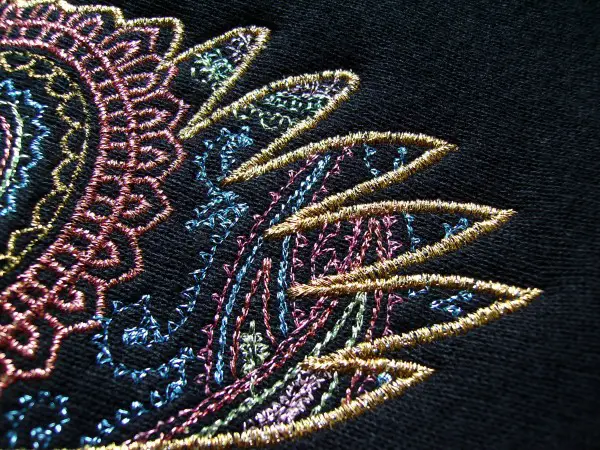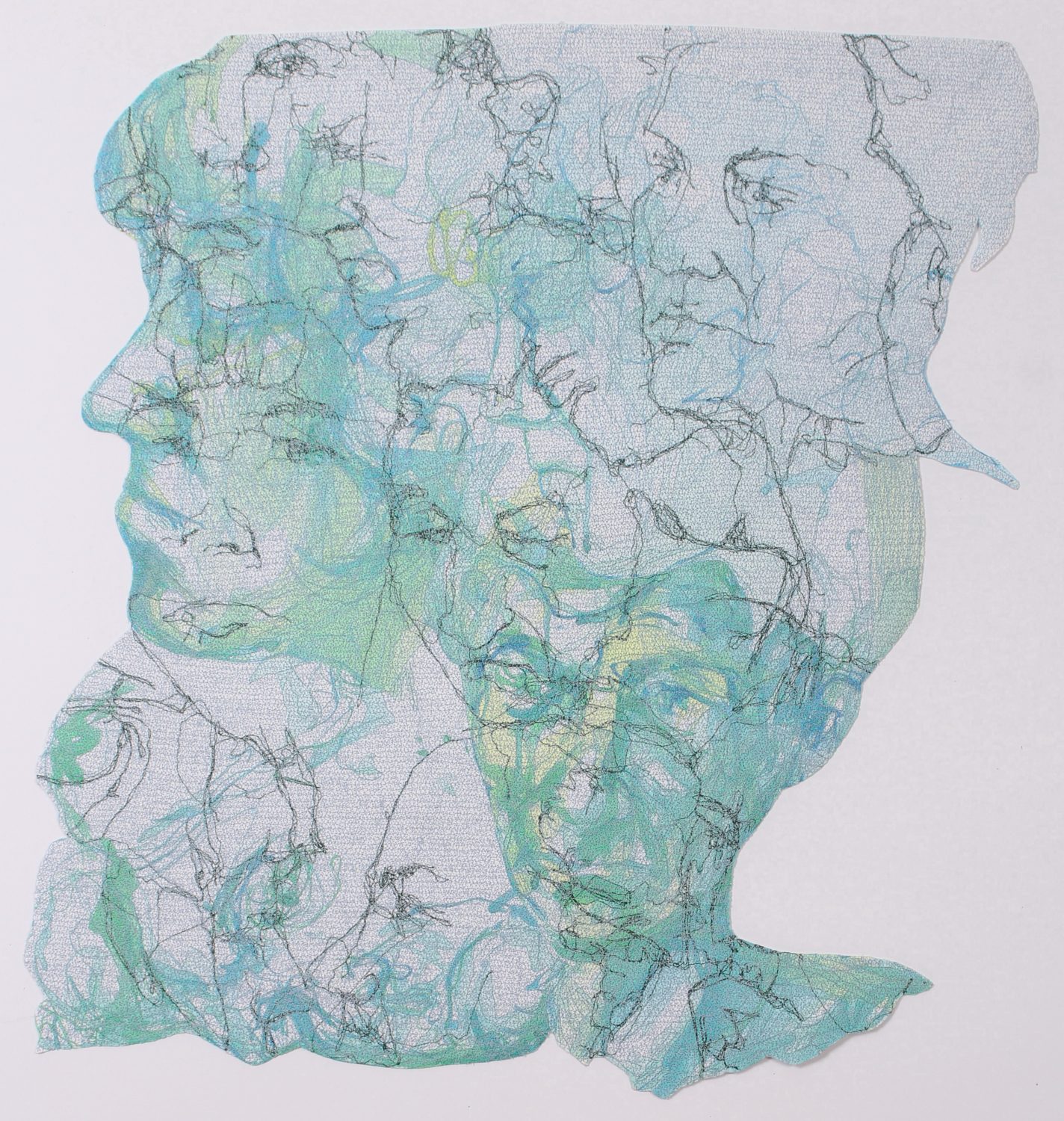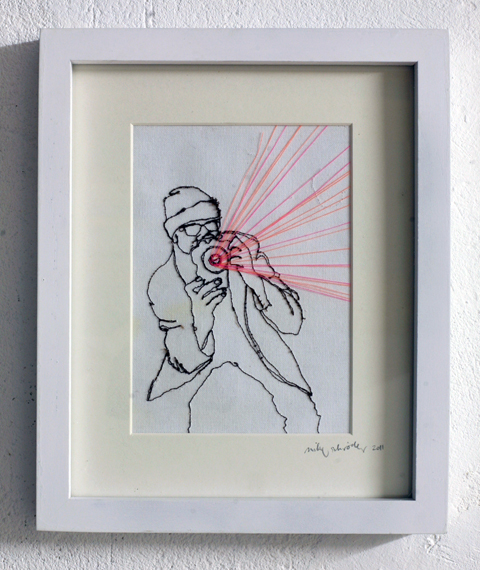In my previous post about stitch types, I revealed the controversial truth the only stitch which an embroidery machine is capable of producing is a single, point-to-point line, meaning that ‘stitch types’ in machine embroidery are simply combinations of these straight stitches worked in different configurations. I finished with a description of each member of the trinity of stitches that make up the largest portion of any machine embroidery design you’ve seen; straight, satin, and fill. Though most designs consist of either manually placed stitches or these three elementary groupings, other stitch types commonly offered in digitizing software are well worth our attention – in the following post (and some yet to come), I’ll focus on a couple of stitch types, describing what they are, how they work, and how they are best used. We’ll start with Bean Stitch and Motif Stitching ( though Motif Stitching is more a tool that can be used to produce a number of stitch types rather than a type of its own.) Without further adieu, let’s get to the stitches.

The bean stitch is the simplest of the two. In essence, bean stitching consists of a line of stitches in which each stitch is worked over 3 or more times with the same penetration points in order to produce a large, thick stitch at each position. It’s called a ‘bean stitch’ because the stitches tend to bow out in the middle and have exaggerated penetration points, making the line of stitching look like a row of beans, or at least that’s the explanation I was given. Each stitch is worked in odd numbers so that the line continues to advance in one direction, unlike a multiple run stitch, in which a row of stitching is simply stitched over twice or more times in the course of the design- with multiple runs, your stitches may not align on the same penetration points, so you don’t get that built up, thick looking ‘bean’ that gives this stitch type its name, even if you use three lines of overlapped straight stitch. Bean stitch is great for making lines that look like they were stitched by hand with large, loose floss; they have a certain rough character and texture that makes them particularly attractive when you are trying to call attention to the textile nature of embroidery or when you want to use a homespun-looking thread to simulate the perceived roughness associated with a hand-worked piece.

Motif Stitching is the repetition of a pre-digitized arrangement of stitches (a motif, of course) either along a drawn line or to fill a defined area. Many software packages contain tools by which one can create an element or use a predefined element that is then set to repeat at a defined spacing and angle. Though the complexity of these tools varies with the software, the basic concept is the same as what many sewing machine owners have had for decades either via specialized design cams or computerized machines; when I first discovered these motifs, I created an entire line of designs with a little laurel wreath made with as simple curve onto which a vine motif was repeated. For someone who had previously been placing each stitch manually, it felt like the best kind of cheating. Motif fills are much the same, just set in both columns and rows, often with an option for spacing in both the x and y axes. They get more complicated in the initial setup than the motif runs, but are essentially the same.

The strength of motif stitches is that one can create and repeat any other kind of stitching along or within any shape one can imagine. I’ve used motif stitching to replicate a vintage chain or split stitch look to great effect. Since I can’t actually create a loop with a standard embroidery machine, I mocked the finished look of the stitch using manual stitches. I replicated a repeating ‘v’ of standard embroidery thread that set with a negatively-spaced distance between stitches allows for the look of a split or chained stitch made of a thicker thread. By creating one of these stitches and saving it as a motif, I can now draw any line and simply convert it to a chain-stitched element.

Motifs can be used any time that you have a line or shape that requires a repeated treatment. One of my favorite pieces of embroidery made extensive uses of motif stitching- in order to create a wide variety of edge treatments and textures in a large area of embroidered paisley, I created motifs for the variety of lines, geometric edgings and fractal-like repeats in the paisley patterns so that I could more easily re-use resize, and mix the elements in constructing the eclectic surface treatment. I could have done these pieces manually, and I certainly returned to stitch-by-stitch editing to clean up odd repeats in the tighter turns and corners, but the time and effort it saved enabled me to work more on the piece as a whole and to try out and replace elements quickly while I worked rather than being stuck in minute detail and/or losing time manually creating elements during that all important initial phase of experimentation.

Both Bean stitches and Motifs can be approximated in any software either manually or through copying and pasting elements, but they truly shine with software that allows for more automation. whether or not you have access to top-of-the-line digitizing, the primary lessons here still have merit; covering a stitch multiple times can give it a chunky, hand-worked look, and by creating groupings of stitches that can be repeated, one can either make a very complex surface treatment with ease or replicate other types of stitches not offered as standard elements in one’s software, up to and including stitches that aren’t truly possible on our machines; the bean and motif stitch share the ability to help one programmatically create these stitches that fool the eye, opening us to a wide range of looks beyond the smooth look one tends to associate with the commercial machine embroidery with which we are most familiar.


—–
![]() Erich Campbell is an award-winning machine embroidery digitizer and designer and a decorated apparel industry expert, frequently contributing articles and interviews to embroidery industry magazines such as Stitches and Printwear as well as a host of blogs, social media groups, and other industry resources.
Erich Campbell is an award-winning machine embroidery digitizer and designer and a decorated apparel industry expert, frequently contributing articles and interviews to embroidery industry magazines such as Stitches and Printwear as well as a host of blogs, social media groups, and other industry resources.
Erich is an evangelist for the craft, a stitch-obsessed embroidery believer, and firmly holds to constant, lifelong learning and the free exchange of technique and experience through conversations with his fellow stitch-workers. A small collection of his original stock designs can be found at The Only Stitch




